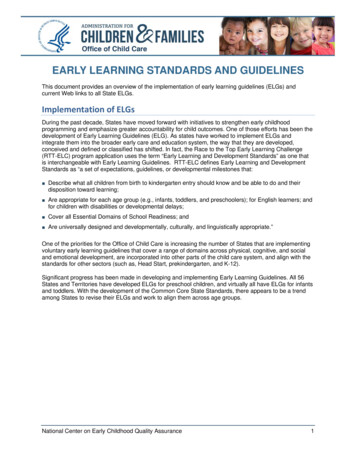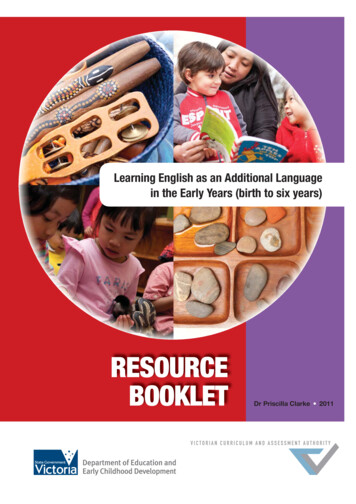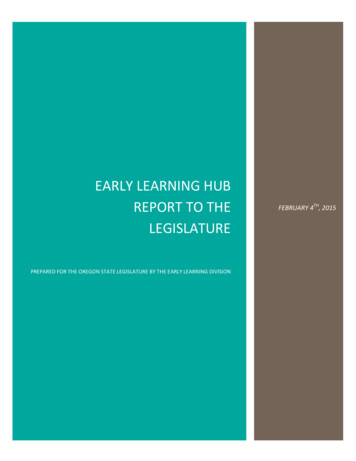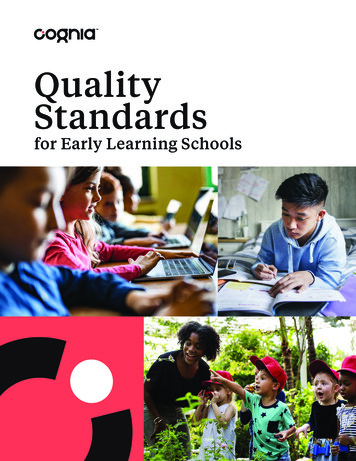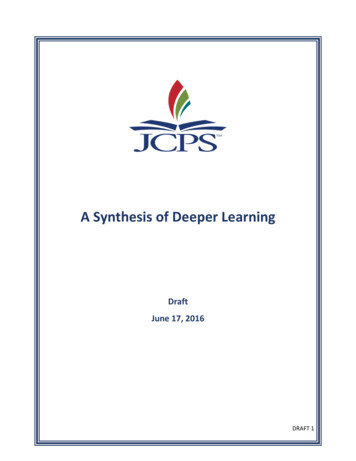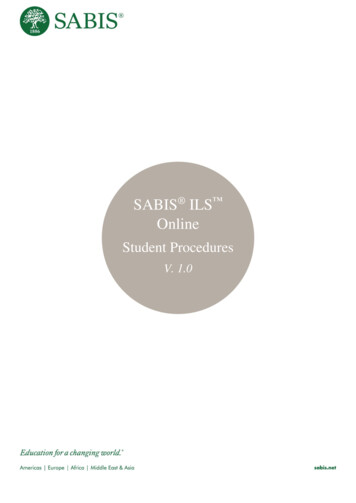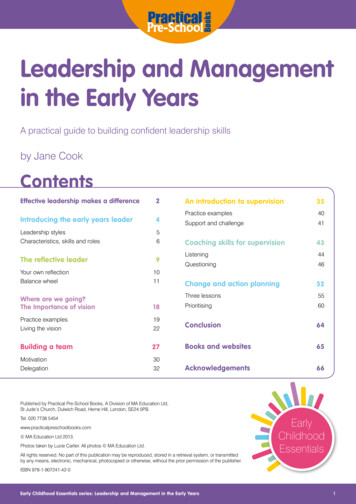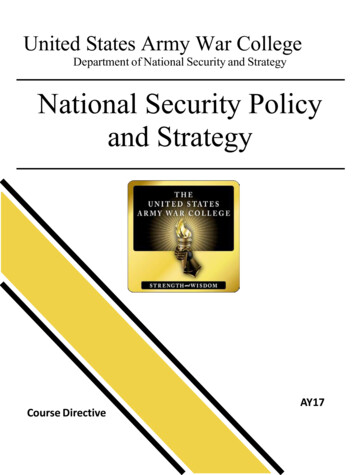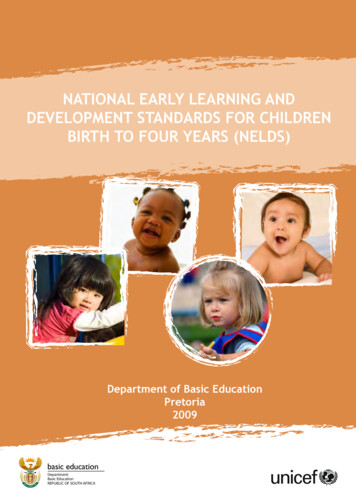
Transcription
NATIONAL EARLY LEARNING ANDDEVELOPMENT STANDARDS FOR CHILDRENBIRTH TO FOUR YEARS (NELDS)Department of Basic EducationPretoria2009basic educationDepartment:Basic EducationREPUBLIC OF SOUTH AFRICA
Department of Basic EducationWith an identification of the Department of Education as source, the document maybe freely quoted, reviewed, abstracted, reproduced and translated, in part or inwhole, but not for sale nor for use in conjunction with commercial purposes.Photography: Unless otherwise indicated, all photographs Dreamstime.comPrepared by and obtainable free of charge from:Directorate: Early Childhood DevelopmentDepartment of Basic EducationPrivate Bag X 895Pretoria0001Telephone: 012-312 5435Email: Samuels.M@doe.gov.zawww.doe.gov.za
NATIONAL EARLY LEARNING ANDDEVELOPMENT STANDARDS FOR CHILDRENBIRTH TO FOUR YEARS(NELDS)Department of Basic EducationPretoria2009
CONTENTSForeword3Acknowledgements4How to Use the Document5Introduction7Section 1: Characteristics of Children Birth to Four Years9Section 2: Strategies for Enabling Positive Growth and Development of Children11Section 3: Desired Results14Section 4: Pointers to Developing Early Childhood Stimulation Programmes33Section 5: Assessment of Children Birth to Four Years35Conclusion37References381
The National Early Learning DevelopmentStandards (NELDS) is a curriculum-relatedpolicy initiative focusing primarily onthe early learning needs of children frombirth to four years.
ForewordSince the new South African political dispensation in 1994, Early ChildhoodDevelopment (ECD) has been recognised and identified as a critical nodalpoint for the country’s social and economic transformation and development.Government departments, together with non-government organisations, haveforged partnerships at different stages of ECD development in the country tocreate policies and programmes that have enabled ECD services to improve.These services mainly pertain to health, social and education needs. Currently ECD in this country boasts someof the best policies in the world. Our focus in deliveringthese policies has been towards ensuring that government resources are used maximally and efficiently tomeet the needs of vulnerable and disadvantaged youngchildren. However, we still need to strengthen the implementation processes of these policies.The National Early Learning Development Standards(NELDS) is a curriculum-related policy initiative focusing primarily on the early learning needs of childrenfrom birth to four years. The development of this document entailed a validation process for verification of thestandards’ content and age appropriateness. Validationconsultations were conducted with various stakeholders such as training organisations and practitioners whoprovided feedback on the validity of the content. The agevalidation informed this final version of the NELDS.NELDS provides early learning standards expressedas desired results, indicators and competencies ofexpected learning achievements for young children in adesignated age range. NELDS also suggests appropriateactivities that adults can initiate to enhance early learning development.NELDS is not an exhaustive list of developmentalmilestones or all the ways in which adults can supportyoung children. It has been designed as the basis fromwhich more comprehensive material can be developedto suit different audiences and contexts in which children are growing, learning and developing. NELDS isdesigned to support work already begun in the sectorthrough strengthening the knowledge and understandingof children’s learning needs and requirements.NELDS will assist ECD trainers and early learningmaterial developers with information and ideas onappropriate content to include in their resources. It istherefore expected that NELDS will be used for a varietyof purposes to improve children’s learning experiencesin the different environments where they are being caredfor. Different resources such as curriculum materials willbe developed for parents, practitioners, teachers andtrainers for enhancing, supporting and enriching children’s learning and development.It is envisaged that NELDS will improve the holisticdevelopment of children through the implementationof creative approaches towards children’s learning,language, literacy and communication, cognition andgeneral knowledge, physical and health well-being, aswell as self-identity and awareness.Effective use of NELDS will assist us as parents,trainers, practitioners, educators and policy makers toprovide the best early learning experiences for the futurecitizens of this country.Mr D HindleDirector-GeneralForeword3
AcknowledgementsThe Department of Education is most grateful to different stakeholders andindividuals for their participation and involvement in the development of the NationalEarly Learning and Development Standards. We would like to acknowledge MsSnoeks Desmond, and Dr Jane Kvlasvig, Dr Kay Governder and Dr Myra Taylor(Child Development Research Unit) who played a key role in the content and agevalidation processes of the standards which resulted in the review and rewriting of thedocument. The department is indebted to UNICEF South Africa which has providedvarious technical supports to the development process of these standards. UNICEF/Rebecca Hearfield4We are also thankful to the Early Childhood Developmentnon-government stakeholders, parents and practitioners who were consulted on the content of the NELDSthrough validation workshops and various other waysin which they participated in this process. The NGOsthat participated are the Early Learning Resource Unit,Cotlands, Centre for Early Childhood Development,South African Congress, Training Resources for EarlyEducation, Custoda Trust, Lesedi Educare Association,Siyathuthuka, Siyathuthutukile Trust, Ntataise, New Beginnings, Centre for Social Development, South AfricanNational Tutor Services, Grow Early Learning Trust andTshepang Educare Trust.Written comments and suggestions were also contributed by education experts from higher education institutions. We acknowledge the inputs from Mrs NdileleniPaulinah Mudzielwana (University of Venda), ProfessorMW de Witt (University of South Africa), Ms Joan Orr(University of South Africa), Dr Nkidi Phatudi (Universityof Pretoria), Dr Hassina Ebrahim (University of KwaZuluNatal) and Ms Elaine Harcombe (Wits University).Lastly, we would like to thank Ms Linda Biersteker forher support in the early stages of the development of thedocument through providing relevant resources.Acknowledgements
How to Use the DocumentNELDS is meant to ensure that the stated developmental expectations inchildren (i.e. desired results) are achieved. In order for this to happen, NELDScan be used and implemented in a variety of ways. The major use should be inthe development of resources and materials for the following: Monitoring national progress in the birth to four years learning programmesImproving early learning and teaching experiencesDesigning and improving parenting skills and programmesAssisting with caregiver preparationsImproving public knowledge of children’s developmentDeveloping school readiness toolsSupporting and improving curriculum developmentEvaluating early learning programmesIt should be noted that there could be other uses for NELDSand we encourage users of this resource to be innovativeand creative in this regard. Uses should also be integrated inorder to gain maximum positive benefit of NELDS.How to Use the Document5
UNICEF/Rebecca HearfieldNELDS promotes using an integratedperspective which reflects the childcareand education curricular visions of thedifferent departments that handle andprovide services for young children.With an integrated approach, the visionof holistic development in South Africanpolicies can be realised.
IntroductionThe National Early Learning and Development Standards (NELDS) has beendesigned as a support for those who want to provide young children withthe best possible start in life. It is based on the understanding that there israpid development in children from birth to four years and that with a solidfoundation they can grow into active and responsible citizens who are wellprepared to make the most of all opportunities and experiences.This document is a starting point for the developmentof, for example, a curriculum; centre or home-basedprogrammes; training courses for practitioners, parentsand other caregivers; evaluation and monitoring tools;and messages advocating for children’s education, careand rights.NELDS contains important developmental indicators and ideas for appropriate activities that adults caninitiate to promote these. It is not an exhaustive list ofdevelopmental milestones or all the ways in which adultscan support young children. It has been designed as thebasis from which more comprehensive material is developed to suit different audiences and contexts. Somecompetencies are repeated across age groups, and someadult strategies are also repeated as it is difficult at timesto make clear divisions in the development of childrenfrom birth to four.It is envisaged that NELDS will help to fill the gap thatexists in the country with regard to the needs of childrenfrom birth to four. It has been developed in the knowledge that the growth and development of young childrenshould be seen holistically and include health, welfare,rights, and education, care and diversity issues.BackgroundIn South Africa Early Childhood Development (ECD) isdefined as “a comprehensive approach to policies andprogrammes for children from birth to nine years with active participation of practitioners, their parents and othercaregivers” (White Paper 5, 2001. p 7). The country’svision for ECD is to protect children’s rights by providingenvironments and resources for the development of achild’s full potential in all aspects of growth and development: cognitive, emotional, social, physical and moral.Research has shown that quality care and educationduring early childhood are beneficial to children’s growthand development throughout their lives. Environmentsand programmes must provide varied and age-appropriate experiences for young children in the years beforeformal schooling. This will ensure that children grow upwith the necessary skills and capabilities to cope with theexpectations of childhood and later, with adulthood.In South Africa, the provisioning and planning of services and programmes for children from birth to four arethe responsibility of several government departments.Internationally this has proved to be problematic and hasled to children’s needs not being adequately and effectively provided for with poor standards of service largelybeing due to lack of coordination and collaboration between departments. Integrated approaches to childcareand education as the best way to meet children’s needsholistically are fast becoming a critical aspect in ECDpolicy development and implementation.The South African government has, through variouspolicies, called for an integrated and intersectoral strategy in order to manage the care and education of childrenfrom birth to four. ECD policies, such as White Paper 5 onEarly Childhood Education and the Social DevelopmentWhite Paper on ECD, emphasise the need for differentdepartments and other organisations to collaborate andwork together on programmes for children from birth tofour. This will ensure that quality and appropriate programmes for the care and education of young childrenare developed and implemented in the country.NELDS promotes using an integrated perspectivewhich reflects the childcare and education curricularvisions of the different departments that handle andprovide services for young children. With an integratedapproach, the vision of holistic development in SouthAfrican policies can be realised.Introduction7
UF/ RNIC Eebe cca Hear fieldChildcare services in South Africa8This document can be used by childcare and education providers in a range of settings. In South Africa,the childcare and education services must providefor all children including those who are orphaned andvulnerable. The following are the categories of servicesprovided: Home care within a family setting Custodial care Private institutions Independent institutions Aftercare services School-based servicesGuiding principlesThe South African Constitution (Act 108 of 1996) emphasises democratic values, social justice, improved qualityof life for all, equality and protection of all citizens. Theguiding principles of this document are based on theConstitution and are therefore that: Adults have the responsibility for ensuring that therights of children are protected and their growth anddevelopment are promoted. Children need to develop a positive self-identity earlyin life. They need to understand their identity as SouthAfrican citizens and aspire to contribute positively to,and benefit from, their community, their country andthe rest of the world. Children need to develop skills, knowledge, values andattitudes for living and coping with life and its challenges, as well as life-long learning experiences. An appreciation and understanding of inclusivity,equity and diversity needs to be fostered in early childhood through anti-bias curriculum practices. An integrated child-centred approach is critical toensure holistic growth and development of youngIntroductionchildren. This allows for a child’s freedom of expression and ability to explore their environment andexperience healthy well-being.Purpose of NELDSThe document is designed toprovide children with the best startin life by equipping their caregivers,teachers, practitioners and parentswith information and knowledge onhow to ensure that their children’searly experiences at home and ininstitutionalised forms of care andeducation are developmentallyappropriate.The document will also specificallyassist in the development ofprogrammes and activities to enablechildren to acquire knowledge, skillsand attitudes that are relevant forfurther and continuous development.It will empower parents andcaregivers on how to enrich children’senvironments by understanding theirgrowth and development processes,their competencies and capabilitiesand what they require.
Section 1: Characteristics of ChildrenBirth to Four YearsThis period in a child’s life is generally characterised and described by thestrands or domains relating to physical, emotional, cognitive, language andsocial development. What children do and are expected to do at differentstages of growth within the above domains/strands can be used to characterise,understand and assess their growth and development.Most children move through similar stages ofdevelopment, but not all children do this at the samepace.Each child is unique and different notonly in their appearance, but also inhow they develop and grow. Most children learn by actively engaging with theworld around them. Each child learns in their own way,and how they grow and develop depends on their environment and the kind of interactions they have withtheir parents, caregivers, peers and siblings. Most children are curious, and adults must take theirexplorations and questions seriously so that learningbecomes an enjoyable experience. Children benefit from a close and loving involvementwith an adult. A stable relationship provides the basisfrom which children can move with confidence fromthe family to being part of the wider community. Children grow up in a diverse society and adults needto help them learn to respect others and to avoid biasbased on race, gender, ability, language or beliefs.In this document, children are categorised into thefollowing age groups on the understanding that therewill be overlap between these. The differences in individual children’s developmental progress and paceare accommodated by using a broad range in the agecategories. Smaller age ranges and the related developmental indicators and competencies could be dealt within programmes that are designed using this document asa starting point.The age categories are: Babies: 0 – 18 months Toddlers: 18 – 36 years Young children: 3 – 4 yearsSection 19
Barriers may slow down growth anddevelopment in children. Children whoexperience these barriers face variousdifficulties that must be understoodin the context of differences in howchildren grow and develop.
Section 2: Strategies for Enabling PositiveGrowth and Development of ChildrenAdults need to ensure that they support children to reach theirfull potential. The following are strategies that are universal andshould be endorsed by all adults: Children need nutritious food and safe sanitation. Children must receive regular routine medical anddental check-ups and immunisations. Medical care must be available when there is concernabout a child’s physical health, development and wellbeing. Opportunities for active play must be provided. Children should have the freedom to choose and directtheir activities according to their individual needs andinterests. Verbal, visual and physical cues must be provided tohelp children learn. Materials in indoor and outdoor environments must beeasily accessible to all children. Indoor and outdoor environments must be safe foryoung children. Children need an adult’s undivided attention when theyare talking or indicating the need to communicate. Children should be encouraged and motivated andshould never be belittled. Discipline must be consistent and age appropriate. A child’s own language should be used wheneverpossible and especially when sharing importantinformation.Barriers to growth and developmentAdults caring for and educating children need to have anunderstanding of barriers to growth and development.These barriers are what make it difficult for a child toreach the developmental milestones that are expectedof them at a particular stage in their lives. These barrierscan be biological, physical, environmental, emotional,mental or social. Some biological and physical barriersare visible and easy to identify, and others are not.Barriers may slow down growth and developmentin children. Children who experience these barriers facevarious difficulties that must be understood in the context of differences in how children grow and develop.Below are examples of some of the difficulties thatchildren with barriers to experience. These difficultiescan be used as signals of problems: Difficulty moving, e.g. grasping an object, walking orcrawling. Difficulty learning to speak and hear. Physical and biological malformations in the body atbirth or during the growth process. Difficulty becoming attached to and interacting withpeople in order to develop relationships. Difficulty with pre-reading and literacy related skills. Difficulty performing given tasks in a learningenvironment. Difficulty remembering or recalling routines orinformation. Lack of self-discipline and self-control. Lack of concentration when engaging in tasks.It is important to note that when children demonstratesome of the above behaviours, it does not necessarilymean that they have barriers to growth and development. The types of behaviours and the extent to whichthey are demonstrated are often signals of some form ofbarrier; an adult should seek assistance to determine theseriousness of these.In cases where barriers to learning are not physicallyobvious, these signals can help in the early identificationof possible barriers. Adults will then be able to help thechild receive the necessary care and support.Section 211
UNICEF/Rebecca HearfieldChildren with barriers, likeany other children, need to beencouraged and praised especially inareas where they are strong and inwhich they have an interest.
UNICEF/Rebecca HearfieldHow to deal with barriers to growth anddevelopment in young childrenAdults need to have a general understanding of how todeal with barriers to growth and development in children and when to contact a specialist who understands,detects and deals with these.The following are general guidelines for dealing withbarriers to learning, and they may apply to home orinstitutional care settings or both: Accept children with barriers for who they are – aschildren with potential in other aspects of growth anddevelopment who need to be nurtured. Take into account the special needs of children withbarriers to growth and development when planningactivities and programmes. Provide the relevant resources and materials neededfor them to develop and grow. Do not treat children with barriers differently from others, except to make provision for what they cannot do. If a child shows any signs of barriers, inform theparents or caregivers but be very certain that you haveproperly identified the problem. Keep a list of information on organisations, associations and medical institutions that deal with barriersto growth and development for consultation andreferrals. Familiarise yourself with government policies,regulations and various documents regarding barriers to growth and development across differentdepartments. Involve them in normal routines and activities in thecentre or home whenever possible. Their barrier/sshould never prevent them from being part of thecentre or their home. Severe barriers need specialist attention and thisshould not be taken lightly. In some cases, childrenwould need to be at special schools or places of care. Parents should not ignore their responsibility to carefor the child. Once a barrier has been identified, theyshould work with other caregivers and specialists tohelp the child as far as possible. Records should be kept of the child’s behaviour andprogress especially at specific times, e.g. when thechild is receiving some form of treatment or specificcare, record their reaction to it.Expert help for barriers to growthand developmentIt is critical to note that in situationswhere signs of barriers to growthand development in a child havebeen identified, consultation with aspecialist in that particular barriershould be sought.Children with barriers, like any other children, need to beencouraged and praised especially in areas where theyare strong and in which they have an interest. Learn more about a child’s specific barrier and findways of helping them to compensate for this.Section 213
Section 3: Desired ResultsChildren are born with some natural abilities andskills which they use to communicate and relateto people and their environments. For children toreach their full potential, they need to be supportedby adults in their homes and in enriched childcareenvironments.Defining desired results14NELDS has adopted the term ‘desired results’ to describethe broadly expected competencies that children shouldacquire and develop through planned and unplannedprogrammes and activities, both in the home and ininstitutionalised care and education environments.These desired results cut across the traditional domainsof childhood development: physical, cognitive, social,emotional, language, perceptual as well as moral andspiritual. Sometimes aesthetic development is alsoadded to this list.NELDS promotes an integrated approach to encompass all the different skills, knowledge and abilities thatchildren are expected and encouraged to attain in thedifferent domains of their development. The integratedapproach is appropriate as it relates directly to how children learn. Children grow and develop through exposureto various experiences which occur concurrently andinteractively, affecting the different areas of child development. For example, a specific experience or activitymight enhance competencies in the social and physicaldomains, as well as in the cognitive domains. It is therefore more critical to highlight the broad competenciesthat children are expected to acquire from a programmeand activities, rather than the specific skills and abilitiesfrom a particular development domain.In NELDS, the same desired results apply to allchildren from birth to four. Each desired result hasindicators and specific competencies. These are outlinedaccording to the different age ranges.The desired results are aimed at:Assisting in ensuring that childrenlearn in an integrated way.Enabling parents, practitionersand other caregivers to provideappropriate programmes andstrategies to support children’slearning activities.Providing the basis for lifelonglearning.The desired results are:Children are learning how to thinkcritically, solve problems and formconcepts.Children are becoming more aware ofthemselves as individuals, developinga positive self-image and learninghow to manage their own behaviour.Children are demonstrating growingawareness of diversity and the need torespect and care for others.Children are learning to communicateeffectively and use languageconfidently.Children are learning aboutmathematical concepts.Children are beginning to demonstratephysical and motor abilities and anunderstanding of a healthy lifestyle.Section 3
The table on the following pages shows the desiredresults with their indicators. The indicators are a breakdown of the knowledge, skills and attitudes which showthat children are working towards achieving the desiredresults. Under each indicator are examples of competencies for each age range, as well as examples of whatparents and other caregivers can do to assist children inthe development of those competencies.Children are unique in every aspect such as how,what and when they learn. Therefore, the competenciesare by no means prescriptive. They are examples of whatparents and educators should be observing and expecting of their children in order to eventually achieve thedesired results. The competencies are also not all fixedin the age ranges indicated; some of them cut across thedifferent age ranges depending on each child’s development and growth experiences.Validation processThere are three stages to producing early learning standards: the development of the standards, validation andimplementation. Validation is the process by which thestandards are tested to find out if what is stated in thestandards is true and accurate. Validation provides scientific information on which recommendations are made asto whether the standards are a reflection of what childrenin a country know and are able to do. Standards are afoundation on which other programmes and initiativesare developed and implemented; for this reason theyneed to be authentic and ethical. Validation helps toensure the authenticity and accuracy of the standards.Validation of these standards has entailed two processes: content validation and age validation. The contentvalidation involved meetings and workshops with: Representatives of ECD non-government organisations Representatives of provincial Departments of Education (ECD) Parents (rural and urban areas) ECD practitioners (rural and urban areas)Written submissions were also obtained from: Higher education institution staff responsible for ECDcourses A provincial ECD working groupDocument analysis was also conducted using relevantECD resources.The comments and findings of the content validationprocess were used to revise and rewrite the NELDS.The content validated and revised NELDS were thenage validated. This process involved identifying relevanttarget groups of children, caregivers and parents fromdiverse social, economic and geographical settings andbackgrounds. The desired results, indicators and competencies were then tested using observations, the KilifiDevelopment Inventory and language tests relevant toeach competency. Changes were made to the standardsfollowing the results of the tests and recommendationswere made.The major result from the age validation for NELDSwas the creation of age validation codes A, B and C to indicate the extent to which the standards were achieved.The coding of the competencies in the standards hasimplications for the uses of the standards, particularly inrelation to the development of curricula as well as teaching and learning programmes.15The codes are:A: This denotes a competency whichshould be achieved by most healthychildren in the age group, with theexception of the very young.B: These are likely to be competencieswhich are relatively new or close tobeing achieved, or not yet performedreliably.C: These are competencies likely tobe achieved only by the older childrenin the age category, or those in veryfavourable environments.Section 3
EARLY LEARNING STANDARDSDESIRED RESULT 1CHILDREN ARE LEARNING HOW TO THINK CRITICALLY, SOLVEPROBLEMS AND FORM CONCEPTSDevelopment area: COGNITIVEIntroductionThe ability to think critically, solve problems and form concepts cuts across allaspects of a child’s growth and development and helps a child to manage and to learnfrom experiences and different situations.Standard 1Children use all their senses to make links between themselves and the objectsaround them and learn that choices have consequences (cause and effect)Age categoriesSome competenciesBabies: 0 – 18 months Use their bodies to explore theirenvironmentA Watches people, objects andeventsA Reaches for an object when it isofferedA Drops objects and watches themfallA Copies holding two objects tobring them together to make asoundB Uses a radial graspB Holds two blocks in one handC Asks the names of things andpeople they seeA Respond to your child and answertheir questions Begins to use most objects fortheir intended purposeA Praise children when they attemptto help themselves Begins to identify relationships,e.g. water and sand make mudA Links sounds to objects or makesrealistic guessesA Involve children in the kitchenwhen it is safe to do so, e.g.mixing juice, mixing dry andwet ingredients when preparingporridge or cakes16Toddlers: 18 – 36 monthsAge validation Some examples of how adultscodescan support the growth anddevelopment of babies and youngchildren Provide safe opportun
The National Early Learning Development Standards (NELDS) is a curriculum-related policy initiative focus-ing primarily on the early learning needs of children from birth to four years. The development of this docu-ment entailed a validation process for verification of the standards' content and age appropriateness. Validation
